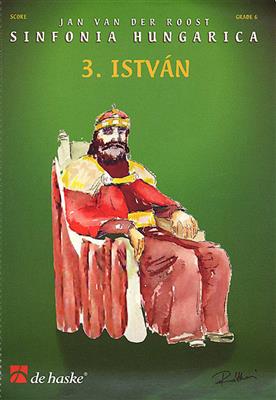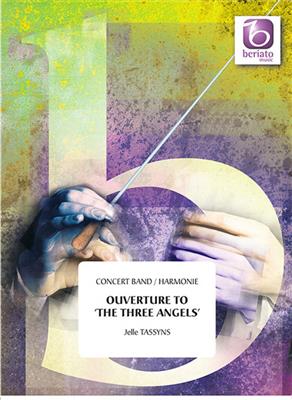Results
-
 £239.99
£239.99Istvn (part 3 from 'Sinfonia Hungarica') - Jan Van der Roost
Sinfonia Hungarica is a three-movement symphony that depicts the history of Hungary. All three movements were inspired by historical key figures, wars, and other important events from this country. This symphony is a celebration of Hungary's millennium in 2001.The final movement is named after ISTVAN, the King who introduced Christianity into Hungary and who was crowned by Pope Silvestro II on January 1, 1001. A rather solemn start leads to another war-like passage, ending with some loud crashes. This symbolizes the fact that the body of the pagan Koppany was cut into four pieces, and sent to the four castles of the country as an example. After a quiet, almost religiousintermezzo, the National Hymn of Hungary is introduced. This broad "grandioso" ending also has a symbolic meaning: after ten centuries, Hungary has many reasons to look back on the past with pride, and to look forward to the future with optimism and confidence.
Estimated dispatch 7-14 working days
-
 £228.70
£228.70Konsertouverture - Viktor Widqvist
This piece was composed in 1937 in the composer's later part of life. Here, Widqvist shows his broad competence as a composer by using both classic marching and late-romantic thematic elements with exciting harmonic twists. In addition, you can find a perfect fugue where the composer shows that he masters this advanced composition technique. One can imagine that Widqvist wanted to show off his entire repertoire of knowledge to take the lead in the unspoken competition with colleague and friend Sam Rydberg. Rydberg had several years earlier composed a concert overture with a similar form. However, this piece is simpler in its design and lacks the technical brilliance that Widqvist shows in his contrapuntal treatment and harmonious diversity.The concert overture was re-orchestrated in 1939 by the composer for symphony orchestra, and it is this version and the original score for a large military orchestra that form the basis for this edition. My aim has been to keep all of Widqvist's original intentions, but still make use of all the possibilities of the modern symphonic wind orchestra. The composer's own arrangements for symphony orchestra have been of great help in this work.- Niclas Blixt -
Estimated dispatch 7-14 working days
-
 £252.10
£252.10Rhapsodie Norvegienne Nr.2 - Johan Halvorsen
This arrangement was written for Dragefjellets Musikkorps Bergen for their performance at the Norwegian Wind Band Championships in 2019.The original orchestral work is one of our country's greatest national works for symphony orchestra.It combines Norwegian folk music with the symphonic tradition, but on a slightly different way than Edvard Grieg.Compared to the original score, I have made parts of the work more chamber-music like by making the instrumentation a bit thinner. By doing this, I hope the span in dynamics will benefit the tutti sections as well. Unlike the symphony orchestra, concert bands do not have the large string section to enrich the soundscape.- Svein H. Giske -
Estimated dispatch 7-14 working days
-
£60.99
Der Zaubermarsch - Rob Ares
On 30th September 1791, a few months before his death, the opera "Die Zauberflote" (The Magic Flute) by Wolfgang Amadeus Mozart was given its first performance. It was remarkable that despite his ill health and his disastrous financial situation he was able to compose a work of such comic genius. Mozart composed the overture in the two days before the premier of the opera and it is on this overture that this transcription is based. To perform the work 'a la Mozart' only the timpani part should be used, the additional percussion parts have been added by the arranger and are therefore optional.Mozart 40th SymphonyThe Austrian composer Wolfgang Amadeus Mozart lived atragically short life of thirty-five years. Towards the end of his life in the summer of 1788, he wrote three symphonies in the span of a little over six weeks. His Symphony No.40 in G Minor was one of those great works. This setting of the first movement from that Symphony provides ample demonstration of the composer's grace, inventiveness and pervasive sense of humour, which can be found throughout his music.
Estimated dispatch 7-14 working days
-
 £102.99
£102.99To my Country - Bernard Zweers
To My Country comes from the trio section of the Dutch composer Bernard Zweer (1854-1924) third symphony. The third symphony was composed at a time when many composers were inspired by great patriotic feelings, and Zweers compositions were said to have been an influence on Dvorak, Smetana, Sibelius and Grieg. The arrangement of this chorale was written for the occasion of the 50th anniversary of the Liberation of the Netherlands on May 5th 1995 and is dedicated 'To My Country'.
Estimated dispatch 7-14 working days
-
 £149.99
£149.99The Lord of the Rings (Excerpts) - Johan de Meij
Johan de Meij's first symphony The Lord of the Rings, based on the famous trilogy by Tolkien, has established itself as a 'classic' piece in the concert band piece repertoire.In this edition, Paul Lavender has masterfully condensed and arranged the symphony into a practical concert version, written at a level and with instrumentation to work within the reach of most bands. This version includes optional cuts allowing several performance lengths and options which enable you to tailor your performances as appropriate. Let your audience experience a fabulous adventure!
Estimated dispatch 7-14 working days
-
 £89.99
£89.99Hobbits Dance & Hymn - Johan de Meij
The famous trilogy The Lord of the Rings by English writer J. R. R. Tolkien, published in 1955, has brought enjoyment to several generations of readers. Johan de Meij himself took the inspiration for his first symphony for Concert Band, The Lord of the Rings, from this great series. This easy arrangement of two movements from the symphony, Hobbits Dance & Hymn, has been carefully carried out by Paul Lavender. An ideal work for all junior bands who wish to play the music of the Concert Band master, Johan de Meij.
Estimated dispatch 7-14 working days
-
 £528.99
£528.99Planet Earth (Complete Edition) - Johan de Meij
Johan de Meijs third symphony, Planet Earth, unmistakeably marksa new peak in his large musical output. The symphonic version waspremiered in 2006 and has now been arranged for wind orchestra by the composer.Planet Earth is an impressive ode to Mother Earth. De Meij has pulled out all stops to sing the earth's praises in a heartrending manner. Splendid melodies, intense intermezzi, surprising sound patterns and noises/sounds from another world create a breathtaking musical experience with an amazing climax.A thrilling and rousing symphony!
Estimated dispatch 7-14 working days
-
 £159.99
£159.99Ouverture To The Three Angels - Jelle Tasseyns
This overture was written in 2000 and pays homage to the composer Paul Hindemith. The composition is based on "Es sungen drei Engel. The song dates back to the 12th century and was originally a Christmas carol. Mahler used this melody in his 'Des Knaben Wunderhorn' and in the finale of his third symphony. Paul Hindemith also uses this melody as a chorale in the 'Engelkonzert' of his 'Mathis der Maler' symphony. This melody is not only used extensively in the 'Overture to The Three Angels', it also forms the main theme of the entire central piece. In this central piece, the melody can first be heard as a fugue by the woodwind instruments and then by the brass instruments andultimately ends in a grand tutti which features all the themes of the entire work. The first and the last part of the composition are not based directly on the chorale melody but constitute a contemporary commentary of the central part. These are not literal references but rather the sounds of the heralds.
Estimated dispatch 7-14 working days
-
 £79.99
£79.99Free Running - Robert Buckley
Free Running is an exciting, high velocity tour-de-force that will keep both musicians and the audience on the edge of their seats. Inspiration for the work came from the pointillistic paintings of Seurat (who created images by using tiny spots of primary colors on his canvas) and from Parkour, a form of urban acrobatics in which participants, known as free runners, use the structures of the rural landscape to perform catlike leaps and sprints. The resulting creation is a non-stop piece of music made up of only staccato notes in a constant rhythm moving through different sections of the ensemble. Free Running was commissioned by the Troy University Symphony Band for the 2011Alabama Music Educators Association Convention. Ideal for concert or festival use, it is guaranteed to leave the audience breathless! Dur: 5:10Recorded by the Troy University Symphony Band - Ralph Ford, conductor
Estimated dispatch 7-14 working days
